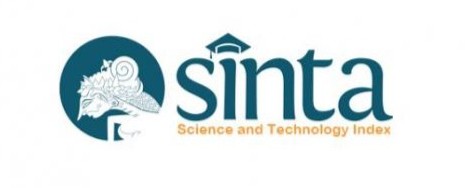THE REPRESENTATION OF SISTERHOOD IN SUSAN GLASPELL'S TRIFLE: PROXEMIC AND KINESIC ANALYSES
Downloads
Abstract: Susan Glaspell's plays have been recognized for its feminist ideologies. The present study traces the representations of the notion of sisterhood in Glaspell's scrip entitled Trifles by employing Barthes' semiotics and Fischer-Lichte's concept of kinesics. Focusing on the gestural and the proxemic signs of the kinesics included in the script, the present study reveals that the notion of sisterhood grows among the female characters in the play through the increasing realization of their similar positions as women in patriarchal society. This development of solidarity among the female characters implies a strong feminist ideology about how women should stand together in facing oppression in male-dominated structures.
Agnus, O. M. (2012). Proxemics: the study of space. IRWLE, 8(1), 1–7.
Balser, D. (1987). Sisterhood & solidarity: Feminism and labor in modern times. South End Press.
Barthes, R. (1982). Empire of Signs (R. Howard (ed.); Vol. 3). Hill and Wang.
Barthes, R. (1987). Myth Today (Mythologies (A. Lavers (ed.); Vol. 3). Hill and Wang.
Ben-Zvi, L. (2002). Susan Glaspell: essays on her theater and fiction. University of Michigan Press.
Blangsinga, G. W. K. A. A., Ni Komang Arie Suwastini, I. W. L., Adnyani, N. L. P. S., & Rusnalasari, Z. D. (2021). Patriarchal Binary Oppositions in Narrative Texts Included in English Textbook for Senior High School in Indonesia'. 2nd International Conference on Technology and Educational Science (ICTES 2020, 135–41. https://doi.org/10.2991/assehr.k.210407.227
Bordwell, D., & Thompson, K. (2010). Film Art: An Introduction (E. Barrosse (ed.); 8th ed.). McGraw Hill.
papers2://publication/uuid/55F69BA0-D1C9-4A5D-AF7B-66770EB13586.
Darling, E., & Whitworth, L. (2007). Women and the making of built space in England, 1870-1950. Ashgate Publishing, Ltd.
Eco, U. (1977). Semiotics of Theatrical Performance. The Drama Review: TDR, 21(1), 107–117. https://doi.org/10.2307/1145112
Elam, K. (1980). The semiotics of theatre and drama. Routledge.
Fisher-Lichte, E. (1992). The semiotics of theatre. trans. Indiana University Press.
Freidan, B. (1963). The Feminine Mystique. W. W. Norton & Company.
Gill, R. (1995). Mastering English Literature. Springer.
Gillis, S., & Hollows, J. (2009). Feminism, Domesticity and Popular Culture. Routledge.
Glaspell, S. (1916). Trifles. University of Babylon Press.
Gupta, V. K., Turban, D. B., & Pareek, A. (2013). Differences between men and women in opportunity evaluation as a function of gender stereotypes and stereotype activation. Entrepreneurship Theory and Practice, 37(4), 771–788.
Hall, E. T., Birdwhistell, R. L., Bock, B., Bohannan, P., Diebold Jr, A. R., Durbin, M., Edmonson, M. S., Fischer, J. L., Hymes, D., & Kimball, S. T. (1968). Proxemics [and comments and replies]. Current Anthropology, 9(2/3), 83–108.
Harrigan, J., Rosenthal, R., Scherer, K. R., & Scherer, K. (2008). New handbook of methods in nonverbal behavior research. Oxford University Press.
Issacharoff, M. (1981). Space and Reference in Drama. Poetics Today, 2(3), 211–224. https://doi.org/10.2307/1772472
Joosa, E. (2012). Drama and dreams: Looking through a Cultural Historical and Semiotic Lens at the Graphic Dramatic Interplay of a Young Adult with Down Syndrome. Cultural-Historical Psychology, 8(1), 26–33.
Lyshaug, B. (2006). Solidarity without" Sisterhood"? Feminism and the Ethics of Coalition Building. Politics & Gender, 2(1), 77.
Riskayani, L., Suwastini, N. K. A., & Wahyuni, L. G. E. (2021). Gender Issues in Mary Norton's Novel Entitled "The Borrowers”: A Library Research'. SPHOTA: Jurnal Linguistik Dan Sastra, 13(2), 1–10. https://doi.org/10.36733/sphota.v13i2.2103
Staiano, K. V. (1979). A semiotic approach to ritual drama. Semiotica, 28(3–4), 225–246.
Suwastini, N. K. A. (2013). PERKEMBANGAN FEMINISME BARAT DARI ABAD KEDELAPAN BELAS HINGGA POSTFEMINISME : SEBUAH TINJAUAN TEORETIS' (Vol. 2, Issue 1, pp. 198–208).
Suwastini, N. K. A., Banjar, I. D. A. O. V. J., Luh Putu Cornea Arya Tienty, I. M. D. G. S., & Nitiasih, P. K. (2020). Rachel Chu as Liberal Feminist in Kevin Kwan's Crazy Rich Asians (2013)'. International Journal of Language and Literature, 4(3), 123–32.
Suwastini, N. K. A., Suprianti, G. A. P., & Fitrianti, N. K. (2018). Are the Women Really Strong? An Analysis on the Characterizations of the Female Main Character in Murti Bunanta's "Seri Wanita Perkasa”'. In I. M. S. P. Made Hery Santosa (Ed.), International Conference on English Across Culture: Vol. IV (pp. 108–19). Undiksha Press.
https://doi.org/10.1002/jctb.5000423502
Suwastini, N. K. A., Suprianti, G. A. P., & Suparyanta, N. T. (2019). Demystification of the Myth of Freedom in the Characterization of Christopher McCandless in Krakauer's Into The Wild'. NOBEL: Journal of Literature and Language Teaching, 10(1), 1–14. https://doi.org/10.15642/NOBEL.2019.10.1.01-14
Tyson, L. (2006). Critical theory today: A user-friendly guide. Routledge.
Veltruskí½, J. (1981). The Prague School Theory of Theater. Poetics Today, 2(3), 225–235. https://doi.org/10.2307/1772473
Wilson, E. (2020). Theatrical Experience (14th ed.). McGraw-Hill Education.
Wilson, Edwin. 2020. Theatrical Experience. 14th Edition. New York: McGraw-Hill Education.

LAKON by Unair is licensed under a Creative Commons Attribution-NonCommercial-ShareAlike 4.0 International License.
1. The journal allows the author to hold the copyright of the article without restrictions.
2. The journal allows the author(s) to retain publishing rights without restrictions
3. The legal formal aspect of journal publication accessibility refers to Creative Commons Attribution-NonCommercial-ShareAlike (CC BY-NC-SA).


.png)













